| |
|
|
| |
How often do you change the fly ? ... revisited.
Tue 19th August, 2014
|
|
|
|
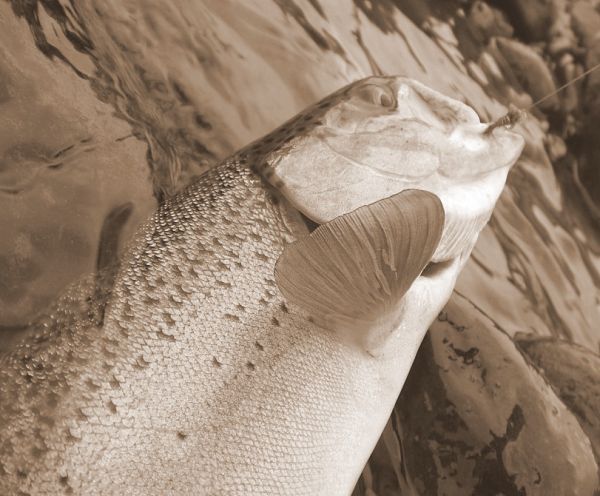
Hi guys, I'm still tied up with other things ... so in the meantime ...
One of the questions you always get asked by anglers who have just started fly fishing is ”how often do you change the fly“? Too be honest there is no easy answer to this one because it depends on so many things and like other aspects of fly fishing it’s a decision that’s based on years of experience which has evolved into a sort of sixth sense. Until you give it some thought you don't even know how you know ... you just do ... but I'm pretty sure no angler turns up at the rivers edge, glances at his watch and says to himself …”I’ll change the fly in ten minutes time“ … it doesn’t work that way.
At the moment we're smack in the middle of the spawning runs { at least we're supposed to be } and fly choice probably isn't as important as it is at other times of the year. During the runs its more about getting your flies down to where the fish are and keeping them there. Whats on the end is secondary although it doesn't take long for our fishy friends to wise-up a bit.
There are two schools of thought on this. Some believe that when trout enter the river to spawn they don't feed again until after spawning. Others ... and I'm one of them ... think that they continue to feed until very near spawning.
Although I don't eat trout myself, now and again I'll take a couple of fresh run fish for friends. I usually gut these for them and always examine the stomach contents. Sometimes they are empty but often both male and female trout will have all kinds of stuff in there ... not all of it insects, bits of stick, small stones, weed, in fact any thing you would normally expect to see floating down a river.
This ties in with what I've often said ... that when trout first return to the river to spawn they don't know a caddis from a cucumber but when feeding they'll take anything that passes close by if it looks as if it might be edible.
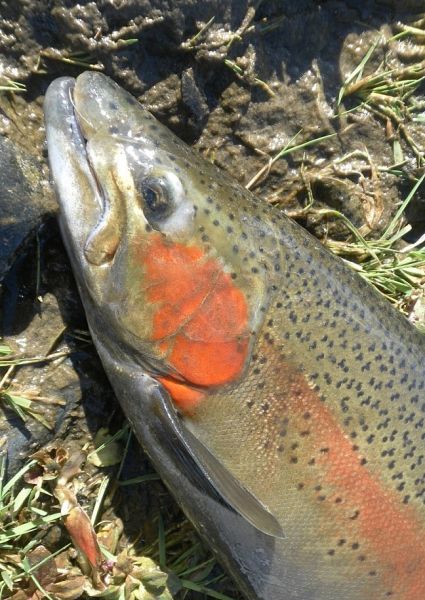
The "stats" show that during this migration most males {but not all} are hooked defending spawning sites. There's no doubt the jacks are hyped up during spawning but there are plenty of fish of both sexes caught well away from traditional spawning areas... I've never been convinced that when a trout takes an anglers fly during the runs its purely because of an aggressive response or curiosity.
Once spawning is out of the way its a quite different story.
They don't suddenly all turn around and head back to the lake. Some remain in the river for several months and some probably don't return to the lake at all. But these " resident " fish all have one thing in common ... they begin to feed like crazy.
Females lose about 25% of their body weight during spawning and to survive and regain that lost condition they need to eat. Males too have to pack in the calories to recover and although most of the fish finish this process by feeding on things like smelt or bullies when they get back to the lake ... it all begins while they're still in the river.
At first they'll scoff anything you put near them but eventually they will start to "choose" what they eat. This is usually influenced by an abundance of a particular insect or a stage in that insects life cycle which makes them standout as an easy meal.
Most of us have favorite “go to flies“ in our box. These are patterns that have consistently caught fish in the past and if you're nymphing the Tongariro odds are it will be something that represents a caddis or mayfly.
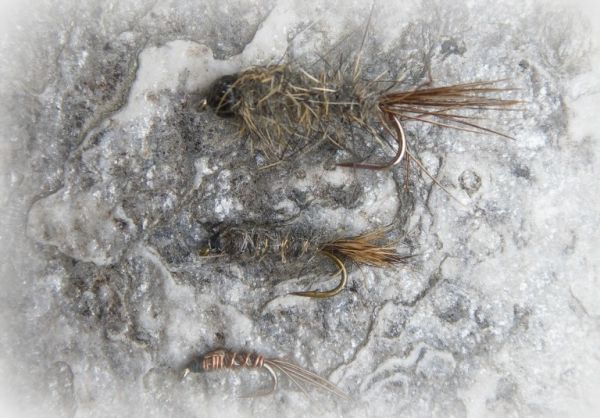 These are lumped under the heading "naturals" in New Zealand. And when I'm fishing naturals under the indicator I usually start with a searching rig consisting of a buggy tied bomb with a couple of flies below it. These are nearly always combinations of a hare and copper, pheasant tail or caddis larvae in size 14 to 16 like the set up on the left … nothing special … no secret flies … just well known patterns that will do a perfectly good job of mimicking the aquatic insects that trout expect to find near the river bed. The hare and copper is one of the oldest and still one of the most effective nymphs out there. If you’re not sure what to use then this is the fly to try first. Its simplicity allows the fish to think its whatever they want it to be and there’s a lot of truth in the old saying that “most of what a trout eats is brown, fuzzy and about a half inch long” . These are lumped under the heading "naturals" in New Zealand. And when I'm fishing naturals under the indicator I usually start with a searching rig consisting of a buggy tied bomb with a couple of flies below it. These are nearly always combinations of a hare and copper, pheasant tail or caddis larvae in size 14 to 16 like the set up on the left … nothing special … no secret flies … just well known patterns that will do a perfectly good job of mimicking the aquatic insects that trout expect to find near the river bed. The hare and copper is one of the oldest and still one of the most effective nymphs out there. If you’re not sure what to use then this is the fly to try first. Its simplicity allows the fish to think its whatever they want it to be and there’s a lot of truth in the old saying that “most of what a trout eats is brown, fuzzy and about a half inch long” .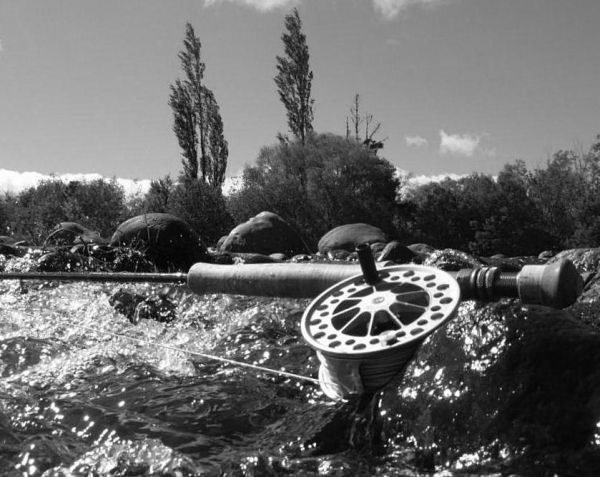
Where ever you're fishing first of all try and guesstimate the depth and set the indicator accordingly. As a rough guide most anglers use the one and a half times the estimated depth formula. So if you think its six feet deep set the indicator around 9 to 10 ft from your flies. Look at the speed the current is flowing, this not only determines leader length and breaking strain but also how much weight to use to get your flies down to trout feeding near the bottom.
Pick out the likely fish holding area’s which we’ve covered before in “reading the water” and as you move through the pool or run fish them thoroughly. In the warmer months keep an eye open for any insect activity around you which could indicate the trout may be feeding on something at or just below the surface, if so you may need to switch to another method. 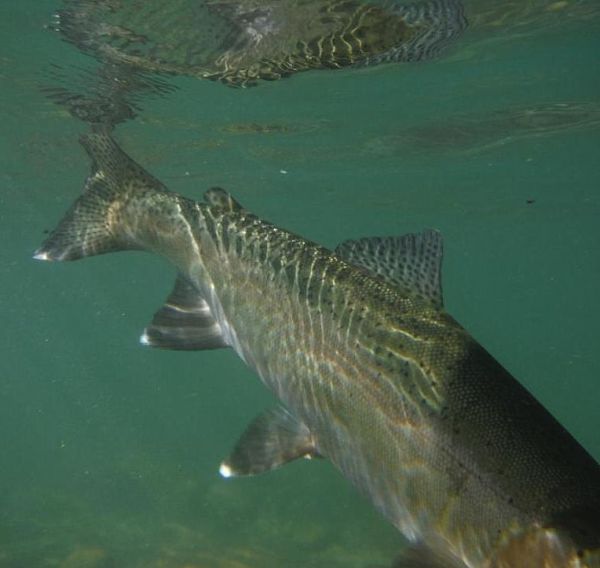
Pay extra attention in faster runs or riffles because if you're a new fly fisher it can sometimes be difficult to spot surface feeding trout in this kind of water and you may miss this cue to change tactics. How’s the water clarity? During low gin clear conditions it may be worth using a lighter breaking strain tippet and leader or try increasing the distance between the bomb and your nymphs. Still no takers ... may be you need to work on your presentation, for instance your mending may not be quite right, making the flies look a bit suspect as they drift downstream. There’s no point tying on a different set if they're going to behave in the same unnatural way as the last lot. In other words heaps of other stuff to think about before you put all the blame onto the poor ole fly. This all sounds a bit complicated but it becomes second nature as your confidence and experience grows.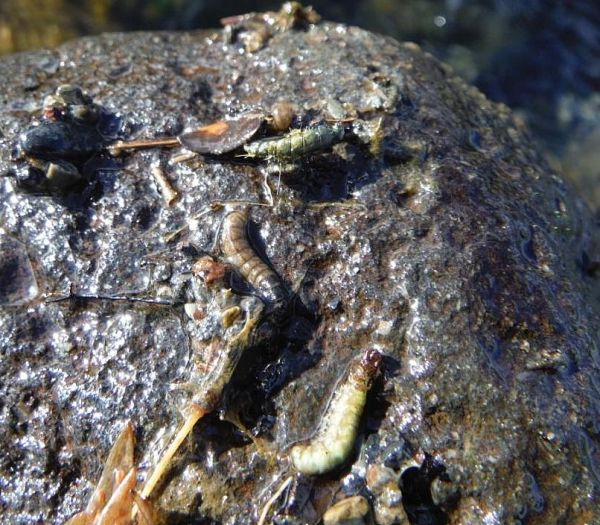 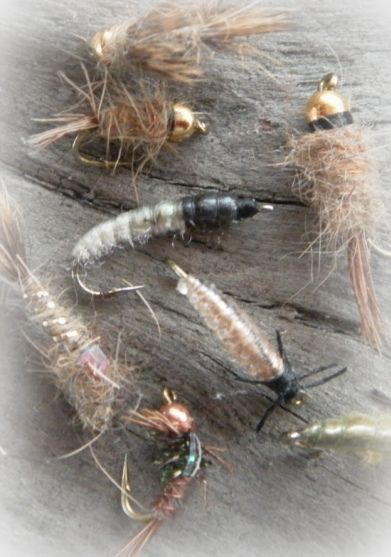
OK … you’ve gone through this check-list and still nothing … now what? This is the time to start thinking about a change of fly. Put the rod down, take a break and spend the time turning over a few rocks in the water above where you’re fishing. Compare what you see underneath with what you’ve been using. Usually you'll find a variety of nymphs and larvae in all sizes but I bet many of them will be a size or two smaller than your artificials, so first of all try a smaller fly.
Sometimes the predominant species on the underside will be caddis larvae. If you’ve been fishing with nymphs switch to a caddis pattern that matches those you’ve found. And if they're free swimming larvae pick one tied with plenty of body segmentation, personally I find they work better.
Something else to bear in mind is that even when the water looks crystal clear there are always all kinds of non-edible bits and pieces being carried downstream. Trout love cool, oxygenated water, e.g., the head of a pool where the river tumbles in from the run above. But you can imagine how it must look below the surface, bits of vegetation, tiny stones and twigs, bubbles etc all mixed up together, yet trout still manage to spot their food.
In conditions like this give them a helping hand and try flies that have a little more “presence”. Patterns tied with rubber legs, flash, colored beads or hot-spots work well here or indeed anywhere that you need your fly to stand out.
So now you've ticked off the remainder of the list and still the indicator hasn't gone under. I think it might be time to make a move and find some easier fish because there are either none in front of you or they're just not feeding. When you're nymphing there are no hard and fast rules on how often you should change your flies because {unlike dry fly fishing} most of the time you can’t actually see the trout refuse them. I suppose it becomes an educated guess at whats happening below the surface. If possible, before I give up on on a place, I like to make at least two passes along the stretch I’m fishing. If nothing happens by the time I get halfway through the second pass then I’ll try a different fly. Some days you get a gut feeling that its worth persevering and you may do this multiple times, other days you just know its not happening and you'll move on fairly quickly.
So ... in answer to the question "how often do you change the fly"?... Well ...it all depends ...
This weeks fishy quote offers another point of view :
" Something to think about :
If you fish the wrong fly long and hard enough, it will sooner or later become the right fly." ~ John Gierach.
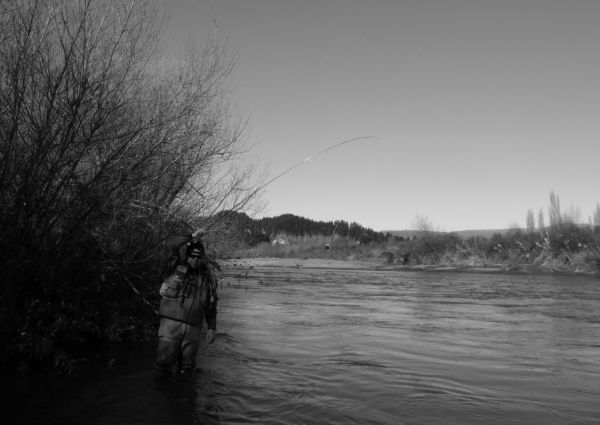 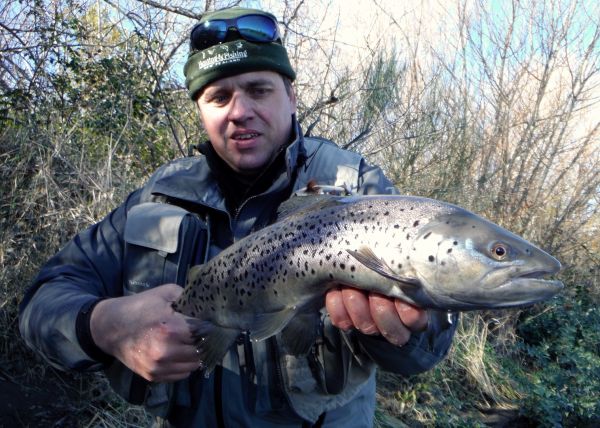
Tight lines guys
Mike |
|
|
| Back to Top |
|
|
|
|
|
|
|